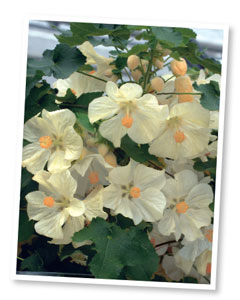6/15/2010
The Appeal of Abutilon
Laurence Pallez

The appeal of
Abutilon hybridum lies in its dual use as an outdoor container or year-round indoor flowering houseplant. Commonly called flowering maple (because of its foliage resemblance to the maple tree leaf), it is a popular garden plant from the mallow family. Its lantern-like buds open to solitary, pendulous bell- to cup-shaped flowers with five overlapping petals. It has significant staminal columns that are typical of mallows, which hummingbirds find irresistible.
You may also notice a similarity to hibiscus. These are cousins of abutilon, and in addition to similar flower shapes, they share the ability to produce dozens of flowers. The blooming season for most abutilon is April through June; however, they often flower periodically through the winter, as well. The large blooms come in colors ranging from white to reds, yellows, oranges and pinks.
The user-friendly seed variety of Bella Abutilon from PanAmerican Seed germinates easily and finishes in 11 to 13 weeks under high light conditions. Bella is a true dwarf abutilon that needs little or no growth regulators. It’s ideal for spring and autumn production schedules in 4- to 8-in. (10- to 20-cm) pots, color bowls and hanging baskets.
Production tips
Light is not needed for germination; cover the seed with coarse vermiculite. Germination is quick—usually in only three days. For plug production, use a well-drained, disease-free, soilless medium with a pH of 5.5 to 6.3 and a medium initial nutrient charge. Germination will occur between 72F to 75F (22C to 24C) with the cotyledon stage emerging at 65F to 72F (18C to 22C). Maintain a 95% relative humidity until cotyledons emerge.
After germination, light can be settled at 1,000 to 2,500 f.c. (10,000 to 30,000 Lux). If temperature can be controlled, seeds can mature in up to 5,000 f.c. (54,000 Lux).
As for soil, keep moisture high until radicle emergence. Reduce moisture levels after the radicle penetrates the medium. Irrigate plants before they are wilted severely to avoid damage.
Abutilon has a moderate fertilizer requirement. At radicle emergence, apply a 50 to 75 ppm N from 15-0-15. As cotyledons expand, increase to 100 to 150 ppm N. Use a fertilizer with most or all of the nitrogen in the nitrate form. High ammonium-form nitrogen will promote excessively large leaves that will hide the flowers. Be careful of excessive fertilization, as it will suppress flowering. Growing the plants too hungry will cause the foliage to turn a pale green and the leaves to look droopy.
No growth regulators are needed to keep its compact habit, and pinching is not needed, either. The best height control and branching is achieved when the plants are spaced as soon as the foliage touches the sides of the pot. If grown pot-tight, apply a Bonzi spray at 5 ppm two to three weeks after transplant. Only one application should be needed.
Crop scheduling
Sow to transplant for abutilon is three to five weeks. Transplant to flower is six to eight weeks at 65F to 70F (18C to 21C). Crop time can increase to 12 weeks with temperatures below 60F (15C). Growth can also be affected at low temperatures and low light. Temperatures above 85F (30C) may cause flower bud abortion. Time to flower is fastest with high light levels. Abutilon is not responsive to photoperiod.
Abutilon flower color in the garden intensifies with cooler conditions, so watch for a good show of color from its large blooms. It’s an easy production item with a semi-tropical look that appeals to many gardeners. Space the plants adequately to get the best branching and the showiest plants.
GT
Ms. Laurence Pallez is an associate product manager for PanAmerican Seed in Elburn, Illinois.